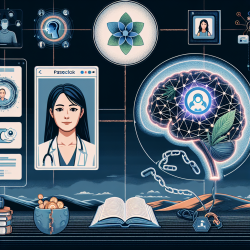Introduction
Specific Language Impairment (SLI) is a condition that affects language comprehension and production in children, without being attributable to hearing loss or other neurological deficits. Recent research, particularly the study titled "Electroencephalographic correlates of word and non-word listening in children with specific language impairment: An observational study," provides valuable insights into the neurophysiological underpinnings of SLI. This blog aims to explore how practitioners can leverage these findings to enhance therapy outcomes for children with SLI.
Understanding the Study
The study utilized electroencephalography (EEG) to examine brain activity in children with SLI compared to typically developing (TD) peers. It focused on the alpha rhythm, a frequency band associated with attention and semantic processing. The researchers observed differences in brain activation during tasks involving listening to words and non-words, particularly in older children (ages 5-6).
Key Findings
- Children with SLI exhibited less alpha desynchronization during listening tasks compared to TD children, indicating difficulties in lexical and phonological processing.
- Non-word listening activated more brain regions than word listening, suggesting a more complex cognitive process when dealing with unfamiliar stimuli.
- Differences in brain activation were more pronounced in older children, highlighting the potential impact of brain maturation on language processing abilities.
Implications for Practice
These findings have several implications for speech-language pathologists working with children with SLI:
- Targeted Interventions: Understanding the specific brain regions involved in language processing can help tailor interventions to target these areas, potentially improving outcomes.
- Focus on Non-Word Repetition: Given the heightened brain activity during non-word tasks, incorporating non-word repetition exercises could enhance phonological processing skills.
- Consideration of Age and Maturation: As brain maturation appears to influence language processing, therapy plans should be age-appropriate and account for developmental stages.
Encouraging Further Research
While this study provides significant insights, it also highlights the need for further research. Future studies could explore the use of other neuroimaging techniques, such as fMRI, to gain a more comprehensive understanding of brain activity in children with SLI. Additionally, expanding the sample to include girls and a broader age range could provide more generalized findings.
Conclusion
The integration of neurophysiological insights into speech-language therapy can potentially transform outcomes for children with SLI. By focusing on data-driven approaches and continuing to explore the neural mechanisms underlying language impairments, practitioners can develop more effective interventions.
To read the original research paper, please follow this link: Electroencephalographic correlates of word and non-word listening in children with specific language impairment: An observational study.










